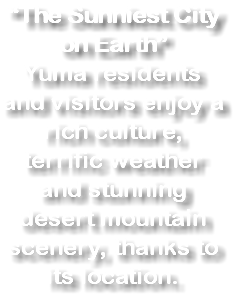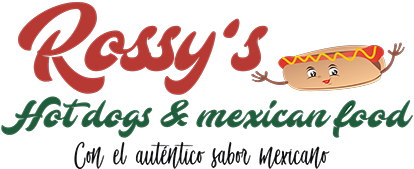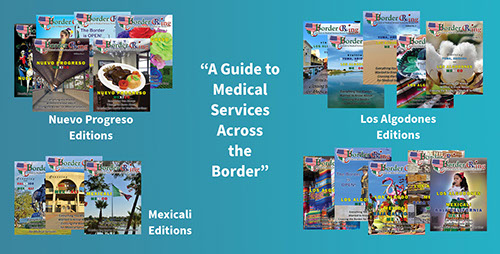DESTINATIONS IN México
STATE OF BAJA CALIFORNIA
Los Algodones
Mexicali
USA side Border Area/Towns
Yuma, Arizona
Imperial Valley, California
Destinations
Medical & Dental Services
Everything You Always Wanted to Know About Crossing the Border for Medical Services

YUMA ARIZONA,
Border Town to the #1 Dental Tourist Destination
-crop-u8119019.jpg?crc=508046383)
-crop-u8119023.jpg?crc=4168841351)
-crop-u8119001.jpg?crc=4249087955)
-crop-u8119011.jpg?crc=3842339516)
-crop-u8119009.jpg?crc=4147253407)
-crop-u8119013.jpg?crc=4156382767)
-crop-u8119005.jpg?crc=4196194794)
-crop-u8119003.jpg?crc=175951612)
-crop-u8119015.jpg?crc=3869423103)
-crop-u8119021.jpg?crc=3782355942)
-crop-u8118999.jpg?crc=4131656515)
-crop-u8119007.jpg?crc=4004503104)
-crop-u8119017.jpg?crc=4046890556)
<
>
About Yuma
Yuma is a border town with México and over the years has served as a gateway. During The Prohibition era it gained more popularity and this popularity has slowly changed to a well sought after Medical Tourism Destination hub.
There is a lot of history in the California-México-Arizona border, near the convergence of the Colorado and Gila rivers.
Spanish explorers, in 1540, coined the name Yuma. Noticing how the Native Americans’ cooking fires filled the valley with smoke, the Spanish called the Indians the Yumas, from the Spanish word for smoke, “Humo”.

Yuma thrives to sustain past as well as future developmental effects, on both the economy and the environment. Yuma Crossing National Heritage Area is a unit of the National Park System and a National Historic Landmark. The first National Heritage Area west of the Mississippi covers 21-square miles encompassing the town of Yuma, Arizona, near the Californian and Mexican borders. Pivot Point Interpretive Plaza is an outdoor exhibit area at the exact site where the first railroad entered Yuma in 1877, it preserves the original concrete pivot on which the rail bridge would turn to allow boats to pass underneath.
Yuma’s historic downtown, with its Yuma Main Street Historic District and Brinley Avenue Historic District, is an important center for the community to include shops, casinos, pubs, theaters, an art gallery, and historic hotels. Along the river, The East Wetlands, an area of 1,400 acres, has been set aside as a nature preserve, a riverfront park the public can enjoy. Listed in the National Register of Historic Places and is now the Yuma Quartermaster Depot State Historic Park displaying five of Arizona’s oldest and best-preserved buildings dating from the 1860’s.
Yuma is a very unique community, many influences coming from a variety of sources starting with the ancestors of the modern day Quechan and Cocopah tribes who settled near the river. The crossing point attracted many over the centuries because of the natural narrowing and calming of the Colorado River. The first Europeans to arrive, in 1540, at the crossing were Spanish explorers. Early expeditions aside, 1680’s brought Spaniards to establish missions and convert the native people to Christianity. But it was not until 1774 that New Spain established relations with the Quechan, who controlled the river crossing. In 1781, the Quechan rebelled and the Spanish never again tried to dominate the Quechan or control the Yuma Crossing.
México won its independence from Spain in 1821. The Mexican-American War of the late 1840s forced México to cede most of what is now the Southwest of the United States, although it was not until the ratification of the Gadsden Purchase in 1854 that the area south of the Gila River, including Yuma, officially became part of the United States.
During the Gold Rush of the mid 1800s, the town saw over 60,000 travelers in one year crossing the Colorado River. With the increase in traffic, in 1852 the U.S. Army established Fort Yuma on Indian Hill, overlooking the crossing. In the 1860s, the U.S. Army created the Quartermaster Depot to supply the new American Southwest outposts and shipped freight and supplies by sea and up the Colorado River by steamships. In the 1860’s, during the Civil war, its status as an ocean port made it one of the busiest - and wildest towns - in the old West. Just imagine the human confluence on these river banks of seafaring sailors, river pilots, soldiers, muleskinners, miners, trappers, outlaws, cowboys, Indians and bandits - and of course, all those others who made their living by meeting their needs. One of its lasting claims to fame is when the Yuma Territorial Prison opened on the twin hill across from the fort in 1876. The railroad, which eventually became part of The Southern Pacific Railroad came in 1877 and was running coast to coast.
Farming has always been the sustaining way of life in this area and continues to prosper today. During the early 1900’s regional development began with an ambitious irrigation scheme called the “Yuma Project”, marking the end of the steamboat era and the beginning of irrigated agriculture.
Yuma was still a place for firsts: The first airplane to land in Arizona touched down here in 1911; the first highway crossing of the Colorado River was the Ocean-to-Ocean Bridge in 1915.
Now activity ramped up in 1941 and Yuma Army Air Base was established at the site. During World War II, Yuma Army Air Base opened and became one of the busiest flight schools in the nation. By 1943, the Army also had opened the Yuma Test Branch at the present-day site of The Yuma Proving Grounds. By 1949, with Yuma’s postwar economy looking a bit grim, the Yuma Jaycees decided to stage an elaborate publicity stunt to spotlight the area’s year-round perfect flying weather: An attempt to set a record for nonstop flying. The record setting plane is on display at the atrium of the City Hall, along with a Buick of the same model and year that was used to set the record. Yuma air field was in fact reactivated in 1951 as a U.S. Air Force facility. Renamed Vincent Air Force Base in 1956, it was signed over to the Navy in 1959 and has been a Marine Corps facility ever since.
Roughly 90,000 winter residents supplement the city’s population and an additional 300,000 visit the city of just under 100,000 residents. Why? Yuma is Arizona’s warmest winter city and the sunniest year round place in the USA. There are more than, 60 RV resorts and parks in the Yuma area. There are a wide variety of accommodations to choose from when visiting Yuma.
Outdoor activities include hiking the deserts, dune bugging, mountain biking, kayaking, canoeing and boating or just floating on the soothing waters of the Colorado River.
Yuma appears to have all the ingredients of a medical tourism hub. Weather, tourist attractions and close proximity to México. Almost 100,000 visitors come from all over The United States and Canada looking for warmer weather during the winter months. An estimated 3,000 visitors cross the border, every day into the town of Los Algodones because it is one of the easiest and safest borders to cross.
.png?crc=4071000984)
.png?crc=3761407418)

Wrapped in Bacon, Grilled
Onions, Jalapeno Sauce, etc
W/side of Yellow Pepper
Mexican
Hot Dogs
Because tacos aren’t just for Tuesdays!
OPEN EVERYDAY AT 5 pm
Sun-Thu til 11pm & Fri-Sat til 1am
Tacos
Burritos
Tortas
Sopes
Corn in a Cup
Quesadillas
and More...
Locally Owned
& Operated
3121 W 8th St, Yuma
(928)304-6998
Storage
Internet Services
Back to the Top
Copyright © 2023 Border CRxing All Rights Reserved






-crop-u10798022.jpg?crc=429002428)

